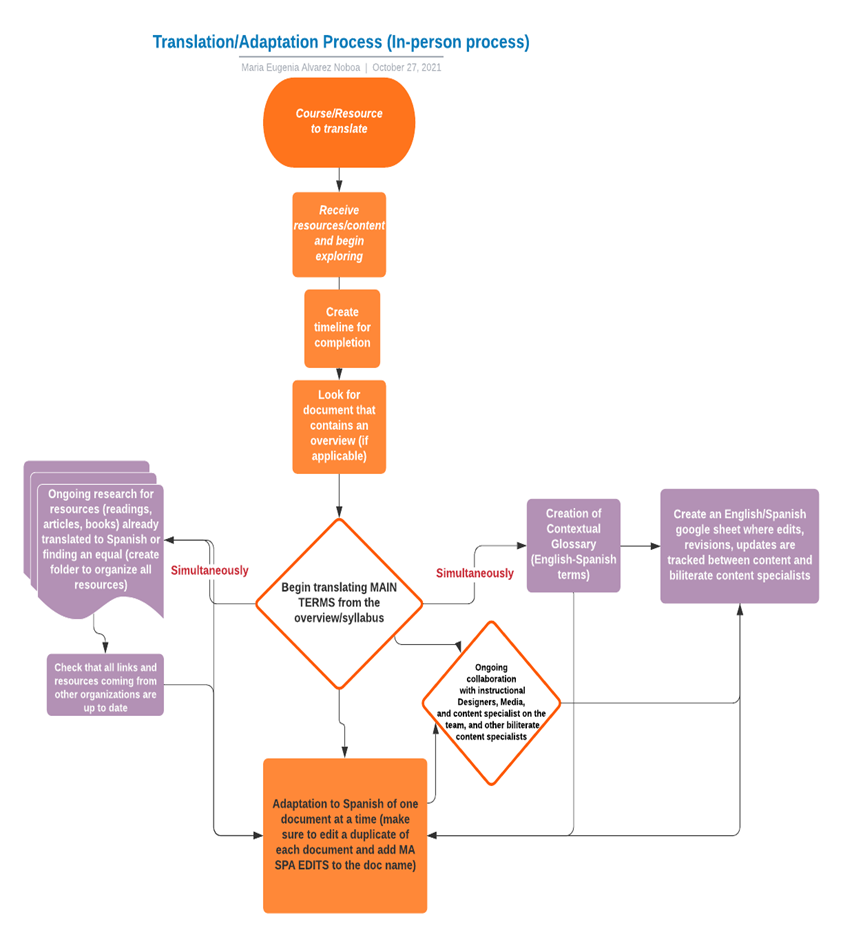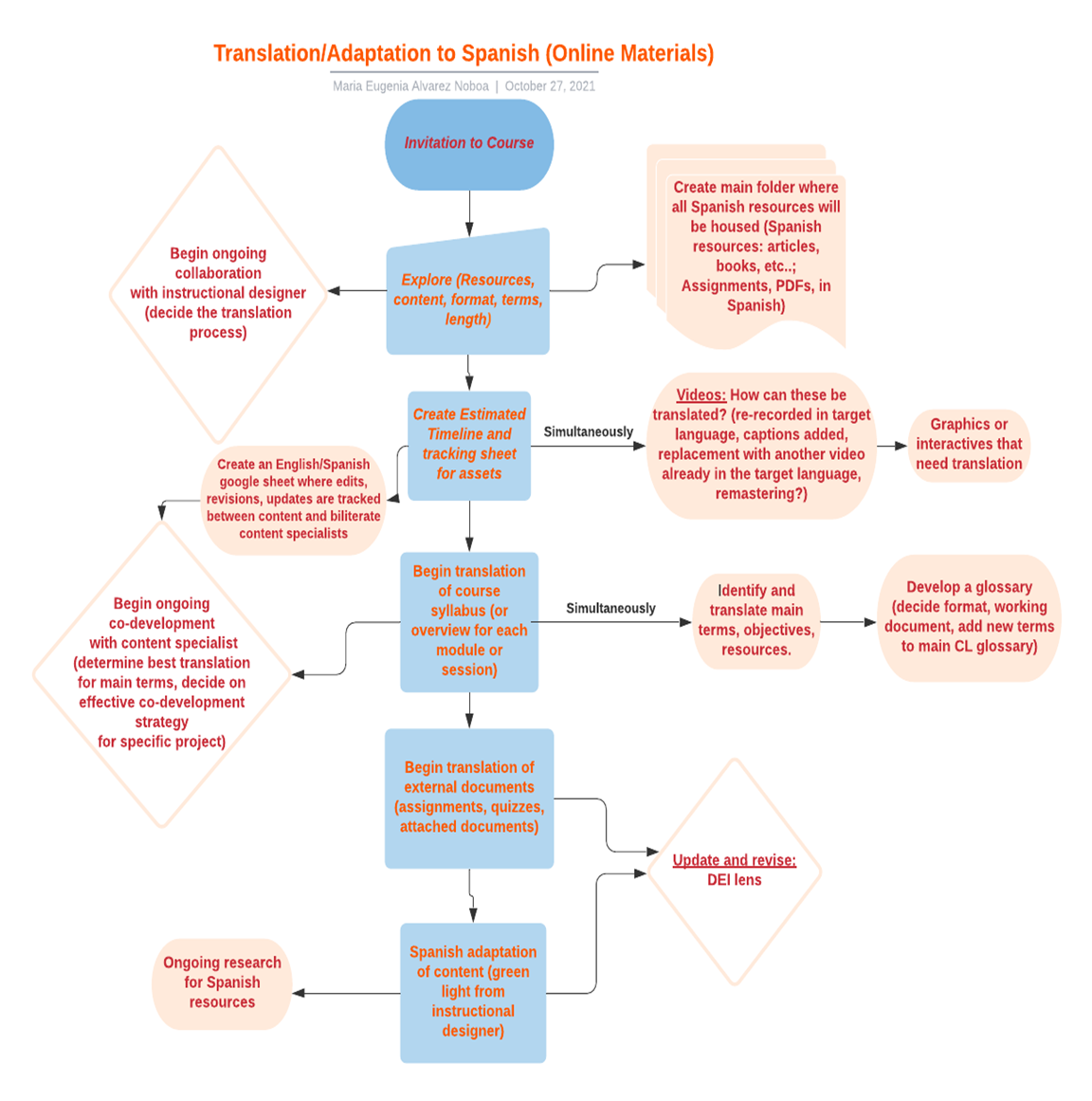Multilingual Transcreation and Translation
Processes
Collaboratively Building a Process and Style
We appreciate the diversity of our audience and make an effort to be as respectful and thoughtful as possible. We welcome contributions to our glossaries from educators in the field, partner organizations, as well as translators contracted by Cultivate Learning to improve the inclusion of the different regional usages of the Spanish and Somali languages.
An online glossary also helps with situations that often arise when materials are sent out to contracted translation companies. With a “real time” glossary, we strengthen consistency in all of Cultivate Learning’s translated materials, at the same time that we build on the richness of the regional and cultural diversity of the Spanish and Somali languages. The glossaries will provide terms corresponding to the different geographic regional usages.
Glossaries are updated on an ongoing basis by staff and partner organizations. New additions to the glossary are shared in the monthly Multilingual Workgroup meetings. Language specific terms and words that are up for debate are discussed in small groups in the monthly Multilingual Workgroup meetings.
While many of our products, deliverables, and materials are developed with a simultaneous multilingual approach, some require using a vendor for translation. Refer to these processes for more information.
Multilingual Considerations for Resources Shared Within Materials and Products
When sharing additional resources like tipsheets, articles, and videos, prioritize quality and scope of the topics addressed, rather than 1-for-1 resource matching. The main focus is on identifying counterpart resources such as tip sheets, articles, and videos. For entire websites that are in English, but may not have an available Somali or Spanish equivalent, we will seek to feature any Somali or Spanish language resources available on that website, but can also keep in mind that most people who have access to websites will also have access to the Google translate feature for the website as a whole. This is particularly relevant to organizational websites (e.g. NAEYC, government sites), where a Spanish or Somali counterpart may not exist.
Translation Processes
Coming Soon!
Translation Process for In-Person Courses

Translation Process for Online Platforms
Canvas

Rise
- Counterparts Light – download file
- ID takes the file and re-inserts into RISE.
Graphic Design and Translation (Internal)
- Content developers will give translators the design package when all the files are ready for translating or QA.
- For files in pdf format, provide links to the pdf, Indd files, fonts and links (the design package).
- For QA, provide the English and translated files so translators can have English to refer to.
- Translator translates or quality checks documents
- Use English file for comparison
- If applicable, download the design package and make changes directly in InDesign files.
- Save a new pdf with translator initials at the end of the file name
- Indd file, fonts and links: It is important that the whole design package (Indd, fonts, links) also comes back.
- When translators complete work, send link to new files back to content developer or project manager for final round of design and proofreading edits:
- Tell the content developer or project manager that translation or QA is complete and needs review by the graphic design team.
- Graphic designer reviews formatting and adds this footer: NOTA DE TRADUCCIÓN: Por favor es importante que sepa que puede haber ligeras discrepancias y diferencias menores entre el texto impreso o electrónico en inglés y el correspondiente texto en español, debido a la edición y actualización de las diferentes versiones.
- Graphic designer sends material back to translator for final proofread. This should be done only in the PDF as it is easier to mark and there are only a few errors by then.
Quick Tips for Captioning, Transcripts, and Translations (Vendor)
- All videos should be captioned in English, and where funding is available, in additional languages. The deliverable will also help to determine captioning needs.
- Project managers, content developers and media producers will coordinate to get videos captioned and applied according to Section 508 accessibility standards.
- The captioning and translation process takes up to 4-8 weeks.
- All materials should be final before sending for translation including accessibility reviews and copy editing. Be sure to copy edit any graphics before submitting, too.
- Use request forms for projects that do not have a biliterate content specialist.
- Include a summary sheet with the request form that includes a list of all materials needing translation and any details that would be helpful. (Alt text, graphics, etc.)
- Be sure to submit all design files when sending projects for translation.
- The project manager and media producer will communicate how to submit video captioning and translation requests when there is a media producer assigned to the project.
- Follow the request process for video captioning when your project does not have an assigned media producer.
- After initial requests are submitted to the vendors (Invoicing etc.), the project manager will be the main point of contact for vendors and the project team.
Request Forms
Captions, Transcripts, and Translation Request – Use this form when requesting any caption or translation services. The project manager and media producer will communicate how to submit video captioning and translation requests.
